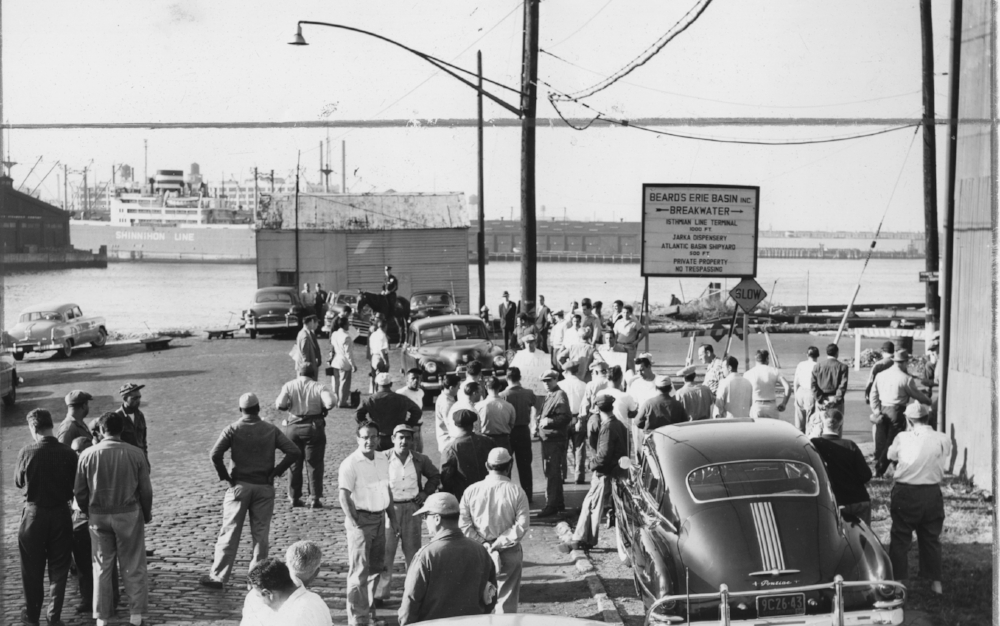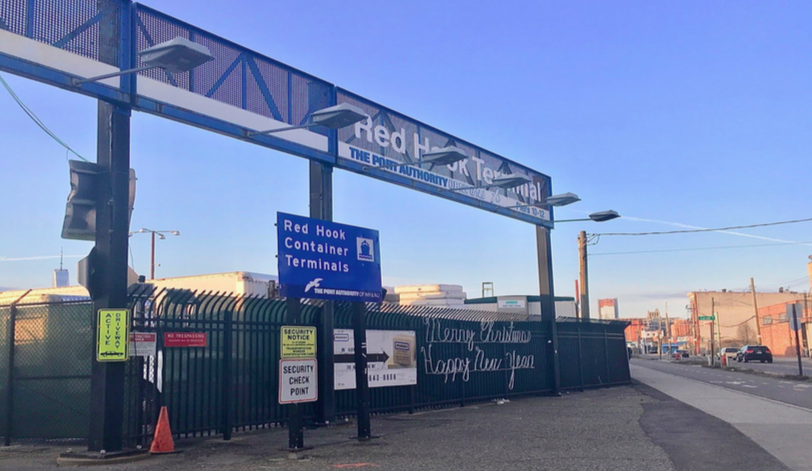Down to the Docks: The Longshoreman Speaks Up
Meave Sheehan
This is an investigation into the figure of the dockworker, also known as a longshoreman or stevedore, who was once a formidable local archetype in the New York area.
This installation was a part of HEAR & NOW: An Interactive Oral History Exhibit, showcasing multimedia projects and stories recorded by the 2017 cohort of Columbia University’s Oral History MA program.
Courtesy of Brooklyn Public Library
The Red Hook Terminal today
What has happened to dockworkers? Oral history interviews that have already been recorded by the Brooklyn Historical Society and Hoboken Historical Museum give us a sense of what the New York area’s shipping industry was like not so long ago. This is a look at one group and subculture of workers that experienced a great change. According to one economist, "Somewhere close to 90% of the dockworkers in New York City lost their jobs within the span of about fifteen years" after a major advance in shipping technology in the 1950s. Visitors can consider the changing nature of labor and what might happen with groups of people whose labor is not considered so necessary anymore. You can also think about the longshoreman culture and what the shipping industry in the modern-day New York area might be like.
THE LONGSHOREMAN IN THE NEW YORK AREA SHIPPING INDUSTRY
What has happened to dockworkers?
This type of worker used to be a noticeable, obvious presence in the New York area. Dockworkers, also known as longshoremen or stevedores populated the piers of Red Hook, Brooklyn, Hoboken, NJ and the West Side of Manhattan.
Many longshoreman jobs went away quickly and permanently as a result of an advancement in technology known as containerization. The shipping industry began to use large metal boxes- containers- to pack goods and the industry needed more space for these containers and the large cranes that lifted them onto and off of ships. Hoboken, NJ, for instance-- known as the one-square-mile city- could not accommodate the space needed for this technological advancement. Shipping companies left that city by 1970.
As jobs in the shipping industry disappeared, local factories closed down and left the area as well. Many factories had been located next to the ports, but containerization made it possible for these factories to relocate further inland and still get the goods they needed in an efficient manner. Thus, port cities, such as Hoboken, NJ also experienced a loss of factory jobs when companies such as Lipton Tea, Tootsie Roll and Maxwell House coffee vacated the city. The situation was similar in Red Hook, Brooklyn. One of the narrators featured in this exhibit, Vincent Favorito, recalls the mills that roasted coffee on the Brooklyn waterfront.
“Somewhere close to 90% of the dockworkers in New York City lost their jobs within the span of about fifteen years after the container came into being,” one economist has stated.
In the New York area, the shipping industry eventually moved most of its operations to a container port in northern NJ, the Port of Newark and Elizabeth. This port, right across the Hudson River, is the third largest port in the country. There are still container terminals in Red Hook.
The shipping industry tried to brace for the coming changes in technology and made plans to ensure provisions for its workforce. In the 1960s, members of the International Longshoremen’s Association (ILA) held several strikes and resisted technological advances. On the East Coast, the ILA successfully negotiated a “container royalty fund,” which to this day provides longshoremen compensation for loss of work. Shipping lines contribute to this fund based on a percentage of the tonnage of containers that are loaded into/out of a given port. In 2011, carriers paid $211 million into this fund.
In addition to technological advancements, power struggles among different factions have impacted the area’s remaining longshoremen. The container royalty fund, for instance, was a point of tension during contract negotiations in 2012 between the ILA and an organization that represents container companies, terminal operators, and port associations, the United States Maritime Alliance.
Investigative reporting and the classic film On The Waterfront brought corruption on the docks to the forefront in the early 1950s, leading to the establishment of a bi-state “watchdog” agency, The Waterfront Commission. In the present day, both longshoremen (ILA) and the managers of area ports (New York Shipping Association, which represents the companies who employ maritime workers) want to dissolve this Commission, partially as a way to regain full control over the industry’s hiring practices.
Currently, human labor makes up less than 4% of shipping costs. What is the future of human labor on the waterfront? While the presence of the maritime industry does not loom as large as it one did in the New York area, there is still very much a working waterfront here.
Sources:
Barrett, Donald “Red.” The Hook : Recollections of Donald “Red” Barrett. Oral history interview, “Vanishing Hoboken” chapbook series. Hoboken Oral History Project. Hoboken Historical Museum. 2015.
Cole, Peter. “Behind the Longshoremen’s Strike Threat.” The Progressive. Dec. 29, 2012.
Favorito, Vincent. Oral history interview conducted by Sadie Sullivan. Jun 10, 2011, Voices of Brooklyn Oral Histories: Our neighbors, 2007- Present , Call number: 2008.031.5.005; Brooklyn Historical Society.
Madrigal, Alexis. Containers podcast. Produced by Fusion Media Group. Spring 2017.
McGeehan, Patrick. “On the Waterfront, a Mob Watchdog is Fighting to Survive.” N.Y./ Region. NY Times. Jan 17, 2018.
Port Authority of NY and NJ website. About the Port webpage. Accessed Jun 13, 2018.
Meave Sheehan has previously worked in local journalism, education, and government. She has a B.A. in English and an M.A. in Liberal Studies. Her research interests include local history, military history, podcasting, and the performance of storytelling.


